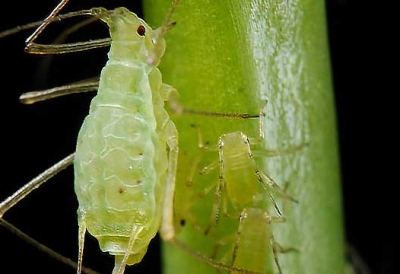Tiny trouble: All about aphids
Aphids Description
Colorado is host to 350 different species of aphids. Almost every tree, shrub and ornamental plant in the state is home to at least one type of this insect. Most aphids don’t injure plants, but some do. However, even aphid species that don’t injure plants can excrete a sticky waste called honeydew that creates a list of annoying problems.
Honeydew can drip and cover anything under an infested plant or tree – including patio furniture and cars. Honeydew that stays on plants is a  perfect growing medium for a gray sooty mold that isn’t just unattractive, it also attracts ants, wasps, bees and flies.
perfect growing medium for a gray sooty mold that isn’t just unattractive, it also attracts ants, wasps, bees and flies.
The most commonly visible aphids are green, but there are almost as many color variations as there are species of the pest. Some cover themselves with waxy threads and are known as woolly aphids.
Another common belief is that they are all wingless. For the most part, that’s true, there are vastly more wingless aphids than winged. But flight is an evolutionary gift if an aphid is part of a very large colony. The live birth issue of an insect that could fly to a less crowded location are much more likely to survive.
Aphids are most likely to be females and they typically reproduce asexually, producing up to five offspring per day for about a month, which is their entire natural lifespan. At the end of the summer, they produce a different variety of offspring that includes males and females. These males and females mate and an egg-producing variety is produced. This variety lays eggs in natural nooks and crannies. The protected eggs overwinter and hatch in spring to start the life cycle anew.
If aphids are a nuisance on your property, contact SprayTech, Colorado commercial and residential weed- and tree-spraying specialists, at 720-248-0000 to discuss treatment options.


Comments are closed.